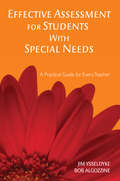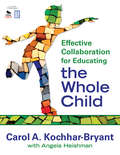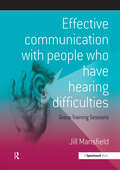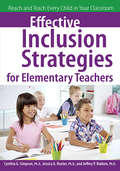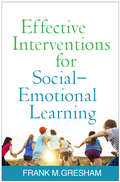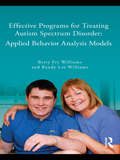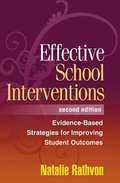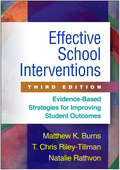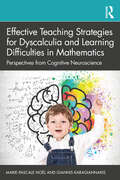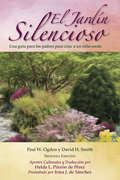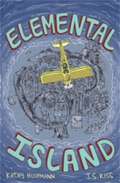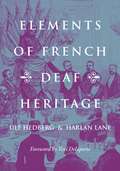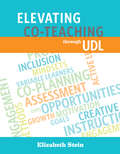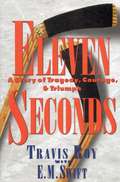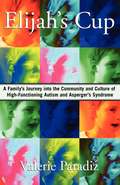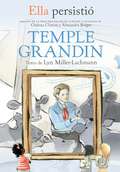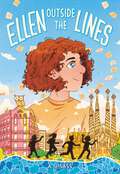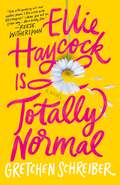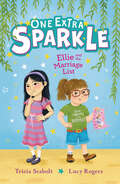- Table View
- List View
Effective Assessment for Students With Special Needs: A Practical Guide for Every Teacher (Practical Approach To Special Education For Every Teacher Ser.)
by Bob Algozzine Dr James E. YsseldykeDiscover what assessment methods you should be using, and how, when, and where they should be administered to ensure appropriate services are selected for all exceptional students.
Effective Collaboration for Educating the Whole Child
by Carol A. Kochhar-Bryant Angela S. HeishmanEducate the whole child by building a culture of collaboration in your school! This book for K–12 general and special education teachers, administrators, and student support specialists explores how to make collaboration and coordination work, who takes responsibility for the process, and why collaboration is central to improving outcomes for students with complex learning needs. The author: Discusses the roles, responsibilities, and relationships between school professionals, community agencies, and service providers Offers case examples as real-world illustrations of collaboration Emphasizes important developmental transitions from the elementary years through high school and after
Effective Communication with People Who Have Hearing Difficulties: Group Training Sessions
by Jill MansfieldOne in seven people in the UK are said to be deaf or hard of hearing. Too often, clients are put off attending centres or have had bad experiences of services and communicating with care or teaching staff. Working through the sessions in this book will enable the reader to understand how to communicate effectively, how to treat individuals with respect and dignity in all types of settings, and how to encourage positive communication with people who have hearing difficulties. The author has used her own experience of deafness to convey the effects it can have on individuals and to give insight into how people with hearing difficulties like to communicate and be treated. Divided into twenty sessions for group training, individuals can also work through the book on their own. The information, exercises, and case studies in this book will provide the reader with the awareness and knowledge to communicate effectively with people who have hearing difficulties. Featuring many cartoon-style illustrations, this photocopiable manual is essential reading for anyone who comes into contact with people who have hearing problems.
Effective Inclusion Strategies for Elementary Teachers
by Cynthia Simpson Jessica Reuter Jeffrey BakkenWritten in a very reader-friendly style with many examples and suggestions, Effective Inclusion Strategies for Elementary Teachers addresses some of the very important issues elementary school teachers face when working with students with disabilities. Topics include an overview of disability laws and definition of inclusion, followed by chapters on students with specific disabilities (autism spectrum disorders, ADHD, learning disabilities, emotional and behavioral disorders, speech and language impairments, hearing impairments, visual impairments, orthopedic impairments, and intellectual disabilities).The remaining chapters in this book discuss the very important topics of technology, collaborating with families, and Response to Intervention. This guide for elementary school teachers is a resource they can come back to over and over again!
Effective Inclusive Schools
by Thomas Hehir Lauren KatzmanHow to raise the achievement of all kids, from gifted to those with severe disabilities This book presents lessons learned from in-depth case studies of some of our most effective inclusive public schools. The authors conclusively demonstrate that schools can educate students with mild and severe disabilities in general education classrooms by providing special education services that link to and bolster general education instruction. This goes beyond complying with Special Education law; having a truly inclusive environment raises the achievement level for all students and results in more committed and satisfied teachers. Insights shared from teachers, school leaders, parents, and the students themselves provide a path forward for anyone striving to Improve special education services. The authors reveal what these exemplary schools do that makes them so successful, and provide advice for readers who want to incorporate these practices themselves. Hehir, former U. S. Office of Special Education (OSEP) Director, is a leading name in Special Education Highlights the important relationships between administrators, teachers, and parents to foster maximum collaboration between general and special education Includes information on committing to Universal Design for Learning (UDL) and Positive Behavior Supports This vital resource zeroes in on what excellent public schools do differently to ensure all students succeed.
Effective Interventions for Social-Emotional Learning
by Frank M. GreshamThis book reviews evidence-based, multi-tiered practices for promoting social-emotional learning (SEL) with typically developing students as well as those with special needs. Leading authority Frank M. Gresham, codeveloper of the Social Skills Improvement System--Rating Scales, describes how to systematically assess K-12 students' social skills and plan and implement universal, selected, and intensive interventions. His approach is grounded in cutting-edge research on social-emotional competencies and their role in adjustment and academic achievement. Emphasizing what works, the book showcases programs and strategies that are sequenced, active, focused, and explicit. Detailed case examples and lesson plans illustrate different levels and types of SEL intervention. Reproducible assessment tools can be downloaded and printed in a convenient 8 1/2" x 11" size.
Effective Programs for Treating Autism Spectrum Disorder: Applied Behavior Analysis Models
by Betty Fry Williams Randy Lee WilliamsEffective Programs for Treating Autism Spectrum Disorder is written for teachers, parents, and the many service providers who work with individuals with autism spectrum disorder (ASD). Part one reviews the characteristics of ASD, summarizes major theories and research findings regarding cause(s) of ASD, and discusses the most popular treatment claims, examining each approach's scientific base and value. Part two provides an informative overview of applied behavior analysis, focusing on the principles of learning and basic procedures based upon those principles. These two parts provide a foundation for understanding the strategies implemented by the outstanding treatment programs described in Part three. The eight models described in Part three represent comprehensive, evidence-based programs for the treatment of persons with ASD, from infancy through adulthood. Programs reviewed include the Lovaas Institute, Koegel Center, Strategic Teaching and Reinforcement Systems (STARS), Project DATA, New England Children's Center, May Institute, Princeton Child Development Institute, and Judge Rotenberg Center. Strategies explained include intensive early behavioral intervention, Pivotal Response Training, verbal behavior, script fading, social stories, visual activity schedules, functional analysis, the Picture Exchange Communication System, and the Family-Teaching Model.
Effective School Interventions, Second Edition
by Natalie Rathvon Paula FreerThis highly practical resource and text presents 70 interventions that have been demonstrated to improve the classroom learning environment, academic achievement, and student behavior and social competence. Each intervention is presented in a brief, standardized format with step-by-step procedures that can easily be implemented by Pre-K-12 teachers and other school-based professionals. The volume includes best-practice guidelines for designing, implementing, and evaluating evidence-based school interventions, as well as strategies for combining multiple interventions to create a comprehensive program at the individual, class, or school wide level. New to This Edition Substantially revised and expanded to reflect significant developments in research and practice. Designed for full compatibility with a response-to-intervention framework.42 of the 70 interventions are entirely new. More in-depth discussions of intervention procedures facilitate implementing and adapting the techniques. A new chapter on preschool interventions. Expanded coverage of curriculum-based measurement procedures. A new category of proactive interventions targeting positive relationships in the classroom.
Effective School Interventions: Evidence-Based Strategies for Improving Student Outcomes
by Natalie Rathvon Matthew K. Burns T. Chris Riley-TillmanThis indispensable course text and practitioner resource, now fully revised, has helped tens of thousands of readers implement evidence-based interventions to improve students' academic achievement and behavior in PreK–12. The volume presents best-practice guidelines and step-by-step procedures for 83 interventions that can easily be implemented by teachers and other school-based professionals. It is a go-to book for those working in a multi-tiered system of support (MTSS) or response-to-intervention (RTI) framework. User-friendly features include recommended print and online resources and 10 reproducible forms. Purchasers get access to a webpage where they can download and print the reproducible materials in a convenient 8 1/2" x 11" size. New to This Edition: *Updated throughout to reflect current research-based best practices. *20 new interventions. *Chapter on important skills for intervention success. *The intensity of each intervention (classwide, small-group, and/or individual) is now specified. *Behavior chapter has been reorganized for easier use. *Downloadable reproducible tools.
Effective Teaching Strategies for Dyscalculia and Learning Difficulties in Mathematics: Perspectives from Cognitive Neuroscience
by Marie-Pascale Noël Giannis KaragiannakisEffective Teaching Strategies for Dyscalculia and Learning Difficulties in Mathematics provides an essential bridge between scientific research and practical interventions with children. It unpacks what we know about the possible cognitive causation of mathematical difficulties in order to improve teaching and therefore learning. Each chapter considers a specific domain of children’s numerical development: counting and the understanding of numbers, understanding of the base-10 system, arithmetic, word problem solving, and understanding rational numbers. The accessible guidance includes a literature review on each topic, surveying how each process develops in children, the difficulties encountered at that level by some pupils, and the intervention studies that have been published. It guides the reader step-by-step through practical guidelines of how to assess these processes and how to build an intervention to help children master them. Illustrated throughout with examples of materials used in the effective interventions described, this essential guide offers deep understanding and effective strategies for developmental and educational psychologists, special educational needs and/or disabilities coordinators, and teachers working with children experiencing mathematical difficulties.
El Jardín Silencioso: Una guía para los padres para criar a un niño sordo
by David H. Smith Paul W. Ogden Helda Pinzón de Pérez Irma J. SánchezDurante más de treinta años, The Silent Garden les ha ofrecido a los padres de niños sordos todo el apoyo y la información imparcial que necesitan para que sus hijos desarrollen su pleno potencial. Esta nueva edición en español, que contiene los cinco primeros capítulos de la tercera edición actualizada en inglés, aporta ayuda a los padres para afrontar aquellos retos tan únicos y complejos a los que se enfrentan. De un modo accessible, práctico y, sobre todo, imparcial, El Jardín Silencioso pone al día a los padres rápida y minuciosamente sobre los muchos y contradictorios puntos de vista que existen acerca del bienestar de los niños sordos. Los autores Paul W. Ogden y David H. Smith, ambos sordos, presentan ejemplos y estudios que les servirán de guía a los padres en un ámbito que a la mayoría les es desconocido. El Jardín Silencioso expone temas como el de las estrategias que los padres pueden adoptar para abordar la situación, el de cómo crear un ambiente familiar sano, el de cómo fomentar la independencia y el de cómo tener en cuenta el punto de vista de los hermanos del niño sordo. Cada tema viene acompañado de historias auténticas que enriquecen la discusión. Siempre en tono alentador, El Jardín Silencioso les otorga recursos a los padres para que se conviertan en los mejores defensores de sus hijos. A lo largo del libro, los autores destacan que cada opción se adhiere a una situación personal diferente y ponen hincapié en que todos los niños sordos tienen la capacidad de llevar una vida enriquecedora, productiva y estimulante. For over 30 years, The Silent Garden has offered parents of deaf children the support and unbiased information needed to fully realize their children’s potential. This new Spanish edition, which contains the first five chapters of the completely updated 3rd English edition, will help parents navigate the complex and unique challenges they face. Accessible, practical, and, above all, open-minded, El Jardín Silencioso educates parents quickly and thoroughly about the many conflicting points of view on what is best for their deaf children. Authors Paul W. Ogden and David H. Smith, who are both deaf, present examples and research that guide parents through often unfamiliar territory. El Jardín Silencioso covers the topics of communication, coping mechanisms for parents, creating healthy family environments, fostering independence, and understanding the perspectives of siblings. Always encouraging, El Jardín Silencioso empowers parents to be the best advocates for their deaf children.
El Manual Sobre la Dislexia: Procedimientos Sobre la Dislexia y Trastornos Relacionados (2014)
by Agencia de Educación de TexasUn manual para dislexia y otros trastornos relacionados. Modificado en 2014.
El arte de no encajar: Lo que pasa cuando el autismo llega a casa
by Noemí Navarro (@noemimisma)El libro testimonial de @Noemimisma Este es el libro que a Noemí le hubiera gustado tener entre las manos el día en que a su hijo Mateo le diagnosticaron TEA. Y el libro que la habría ayudado a entender su propio caso cuando, al cabo del tiempo, descubrió que también ella era una persona con autismo. ¿Cómo gestionar la incertidumbre? ¿Cómo afrontar el miedo que sientes como madre? ¿Cómo tratarlo con los hermanos? ¿Y con la pareja? ¿Qué decirle a la gente que quiere ayudar, pero no sabe cómo? ¿Qué recursos hay? Pero en él no solo nos habla de esta realidad, sino que hace un recorrido por su vida y su maternidad. En forma de entrevista, este potente memoir lleno de entresijos emocionales pretende inspirar y ayudar con herramientas y recursos a todos aquellos lectores que tengan cerca un ser querido neurodivergente, para que -como declara la autora- «hagan de la vida de ambos una vida plena».
El libro de Mamá Cultiva Argentina
by Mamá Cultiva ArgentinaUn grupo de madres y pacientes unidos por una problemática común creó la ONG Mamá Cultiva Argentina y convenció a los legisladores de la importancia de acceder a medicamentos producidos en base a extractos de la planta de cannabis para aliviar dolencias crónicas y severas padecidas por numerosos niños, jóvenes, adultos y ancianos de nuestro país. Valeria Salech irradia con naturalidad las virtudes ocultas en el significado de su nombre. De casualidad conocí su valor y valentía en 2017, pocos días antes de la sanción de la Ley 27350 de cannabis medicinal, en una gesta cívica librada por un pequeño colectivo de mujeres que reclamaron y convencieron a legisladores de ambas cámaras de que los prejuicios y la ignorancia solo aseguran más dolor. Para evitar que otras familias transiten por tenebrosos laberintos sin salida, Valeria fundó Mamá Cultiva Argentina, una ONG que logra contener, orientar, integrar y difundir experiencias que afectan a miles de personas en nuestro país. Con la necesidad creciente de compartir sus historias, Valeria recorre los padecimientos, las batallas y las conquistas de familias antes perturbadas por la tristeza, el dolor y la falta de perspectivas luminosas. Este libro cuenta la lucha de Valeria por su hijo Emiliano, quien a poco de nacer manifestó convulsiones frecuentes de alta intensidad, que nunca se detuvieron ante una calesita incesante de neurólogos apurados y fármacos ineficaces. Descartando el "no hay solución" como respuesta, Valeria se aferró a su valor y valentía para indagar en los potenciales beneficios del aceite de cannabis, y desde el primer día descubrió la calma, la sonrisa y la conexión de Emiliano con toda la familia. No fue magia ni fruto de una planta milagrosa: el cannabis posee moléculas capaces de apaciguar impulsos nerviosos mediante la activación de receptores presentes en el cerebro que evitan disparos descontrolados en nuestros circuitos neuronales. La historia de Valeria y de Mamá Cultiva Argentina es un ejemplo de valor y valentía, de aprendizaje y soberanía sanitaria, de la lucha por una salud más inclusiva, humanizada y desprejuiciada.
El último verano
by Anne BertAmaba su existencia con pasión, pero estaba condenada, y Anne Bert decidió elegir no sufrir hasta el final la tortura infligida por la esclerosis lateral amiotrófica. Este es el viaje definitivo de la autora. El que la obligó a morir fuera de la ley, prisionera de sí misma, porque la justicia francesa no autorizó acortar su sufrimiento. Una sugerente invitación a descubrir el sabor de los momentos finales; a aprender a pensar en la muerte; a despedirse de los seres que uno quiere, y a enfrentar el reto de las últimas alegrías a pesar del dolor. Una oda a la libertad y a la vida, solo posible por la determinación de esta escritora a eludir el deterioro final. «A la luz de este último verano que saboreo, tan rodeada y, sin embargo, tan solitaria, estos son los fragmentos de este cara a cara con la mortalidad».
Elemental Island
by Kathy Hoopmann J. S. Kiss*Silver medal winner in the 'Middle Grades Fiction' category of the Nautilus Book Awards 2015* Astie has always been different. Her 12th birthday is looming and she still has not decided on her thesis. All the Learners at the Hub picked theirs years ago. If it wasn't for her cousin, Jakob, life would be unbearable on Elemental Island. On the verge of being diagnosed with Social Syndrome, she stumbles upon Danny who has landed in a forbidden flight machine. To protect him, Astie persuades Jakob to tamper with the Overseer's memory. On the run from the Monitors together, Astie calls on her unique qualities to forge a friendship with the stranger and discover his reason for coming to the island. What she finds will shake the foundations of the place she calls home. Set on a secretive island utopia where science and logic rule, this intriguing novel explores and celebrates differences in people from an alternative perspective. It is engaging reading for children aged 8-13.
Elements of French Deaf Heritage
by Harlan Lane Ulf HedbergFrench Deaf culture is regarded as a major influence on the formation of other Deaf cultures around the world, notably American Deaf culture. In Elements of French Deaf Heritage, Ulf Hedberg and Harlan Lane document the development of Deaf culture in France by way of Deaf schools, Deaf associations, private and professional networks, publishing, and the arts. This highly visual work captures these forces from the late 18th century through the end of the 19th century, when cultural formation began to shift to cultural maintenance. Encyclopedic in scope, this examination of the evolution of Deaf ethnicity in France aims to disseminate an extensive amount of archival information, now available for the first time in the English language.
Elevating Co-Teaching through UDL
by Elizabeth SteinCo-teaching--the practice of having special education and regular education teachers work together in inclusive classrooms--is one way to ensure that all students have equal access to challenging academic content. But the practice is a challenging one, requiring thoughtful planning and execution by cooperative classroom professionals. Universal Design for Learning (UDL), a framework for designing inclusive learning environments, offers co-teachers structure and guidance in pursuing their goal to create successful learning environments for all students. In this book, veteran co-teacher and UDL expert Elizabeth Stein shows how to apply the UDL principles and guidelines to the practice of co-teaching. How does UDL inform the lesson-planning process? What does UDL look like in the classroom? What role does formative assessment play? How do you get buy-in for the UDL approach from administrators, parents, and students themselves? These and other questions are answered in this must-have book for anyone interested in co-teaching.
Eleven Seconds: A Story of Tragedy, Courage, and Triumph
by Travis Roy E. M. SwiftEleven seconds was all it took. Eleven seconds to stop cold a shining career scarcely before it had taken off on the ice. Travis Roy was a promising twenty-year-old hockey star. Then moments into his first collegiate game as a Boston University freshman, a freak accident drove Travis into the boards. A cracked fourth vertebra left him paralyzed from the neck down. That fateful October night in 1995 signaled the death of one dream - but also the eventual rebirth of a special kind of hope. For, though imprisoned for months in a hospital bed, then confined to a wheelchair, Travis gradually found the grit and the will to reclaim for himself a fulfilling and productive life. Eleven seconds is a story about America's love affair with sports and the people who embrace its never-die spirit. Most of all, it is the story of one young man who surrendered to no limits and defied all odds, both before and after the tragedy that ended his game.
Eli, The Boy Who Hated to Write: Understanding Dysgraphia (2nd Edition)
by Eli I. Richards Regina RichardsA book that challenges all to an emotional connection to children suffering from dysgraphia. It discusses the issues associated with it and the children's experiences; continually providing teachers, parents with additional information on the same as they are the cores in helping the kids get through by understanding their issues for them to grow academically and professionally.
Elijah's Cup: A Family's Journey into the Community and Culture of High-functioning Autism and Asperger's Syndrome
by Valerie ParadizParadiz, the co-founder and director of a school for autistic teens, chronicles her life with her son, Elijah, diagnosed with Asperger's syndrome. Her inspiring narrative celebrates the idiosyncratic beauty of the Asperger mind and the sense of mutual support and self-respect in the Asperger's syndrome community. This paperback edition includes a new chapter bringing readers up to date on Elijah's education and his mother's advocacy work, and an afterword by Elijah himself. Annotation ©2006 Book News, Inc. , Portland, OR (booknews. com)
Ella persistió: Temple Grandin / She Persisted: Temple Grandin
by Lyn Miller-Lachmann Chelsea ClintonInspirado en el bestseller #1 del New York Times Ella persistió de Chelsea Clinton y Alexandra Boiger, llega ahora esta serie en Chapter Books sobre mujeres que sobresalieron, lucharon y se levantaron contra viento y marea. Cuando las vacas, los caballos y otros animales sufrían, Temple Grandin parecía entenderlos mejor que nadie. Temple es autista, y esto determinó que pensara de una manera diferente al resto de las personas; no inferior, solo diferente. Cuando llegó a la edad adulta, se esforzó por explicar cómo el hecho de ser autista influyó en su trabajo y en su vida, ayudando a las personas sin autismo a comprender mejor a las que lo tenían. Temple se convirtió en una científica de renombre mundial, experta en comportamiento animal, y ha utilizado su forma de ver el mundo para inventar y lograr grandes cosas, siempre ayudando a otros en el camino. En este libro biográfico de la galardonada autora Lyn Miller-Lachmann, los lectores aprenden sobre la asombrosa vida de Temple Grandin y cómo persistió. ¡El libro se completa con una introducción de Chelsea Clinton!
Ellen Outside the Lines
by A. J. SassWinner of a Sydney Taylor Book Award Honor! A heartfelt novel about a neurodivergent thirteen-year-old navigating changing friendships, a school trip, and expanding horizons for fans of Rain Reign and Ivy Aberdeen's Letter to the World. Thirteen-year-old Ellen Katz feels most comfortable when her life is well planned out and people fit neatly into her predefined categories. She attends temple with Abba and Mom every Friday and Saturday. Ellen only gets crushes on girls, never boys, and she knows she can always rely on her best-and-only friend, Laurel, to help navigate social situations at their private Georgia middle school. Laurel has always made Ellen feel like being autistic is no big deal. But lately, Laurel has started making more friends, and cancelling more weekend plans with Ellen than she keeps. A school trip to Barcelona seems like the perfect place for Ellen to get their friendship back on track. Except it doesn't. Toss in a new nonbinary classmate whose identity has Ellen questioning her very binary way of seeing the world, homesickness, a scavenger hunt-style team project that takes the students through Barcelona to learn about Spanish culture and this trip is anything but what Ellen planned. Making new friends and letting go of old ones is never easy, but Ellen might just find a comfortable new place for herself if she can learn to embrace the fact that life doesn't always stick to a planned itinerary.
Ellie Haycock Is Totally Normal
by Gretchen SchreiberThe Breakfast Club meets Five Feet Apart in this big-hearted novel from debut author Gretchen Schreiber.Ellie Haycock has always separated her life into sections: Ellie at home and Ellie at the hospital. At home, Ellie is a proud member of her high school’s speech and debate team alongside her best friend and her boyfriend. At the hospital, Ellie has a team of doctors and a mom who won’t stop posting about the details of her illness online. It’s not hard for Ellie to choose which of the two she prefers.But this latest hospital stay is different. Ellie becomes close with a group of friends, including Ryan, a first-timer who’s still optimistic about the doctors that Ellie stopped trusting years ago. Despite their differences, she can’t seem to keep him out of her head. Ellie’s life has never been ordinary—but maybe this time it will be extraordinary.
Ellie and the Marriage List
by Tricia SeaboltEllie is ready to have the best summer ever. She's especially excited to draw under her favorite tree and hang out with her big brother, Ben. But all Ben seems to care about is impressing the new lip-glossy neighbor, Sara. And all Sara seems to care about is turning Ellie's brother into a Hawaii husband! Luckily, Ellie's best friend, Ling, has the marriage list—a top-secret tool to track the lovebirds and stop a wedding before it starts. But nothing goes to plan, and while trying to rescue Ben, Ellie ends up putting the weeping willow in her garden in danger. Faced with losing everything she loves most, can Ellie find a way to win back her brother and save her beloved tree? An utterly charming story about a lovable 10-year-old with Down syndrome whose extra sparkle never fails to shine bright.
